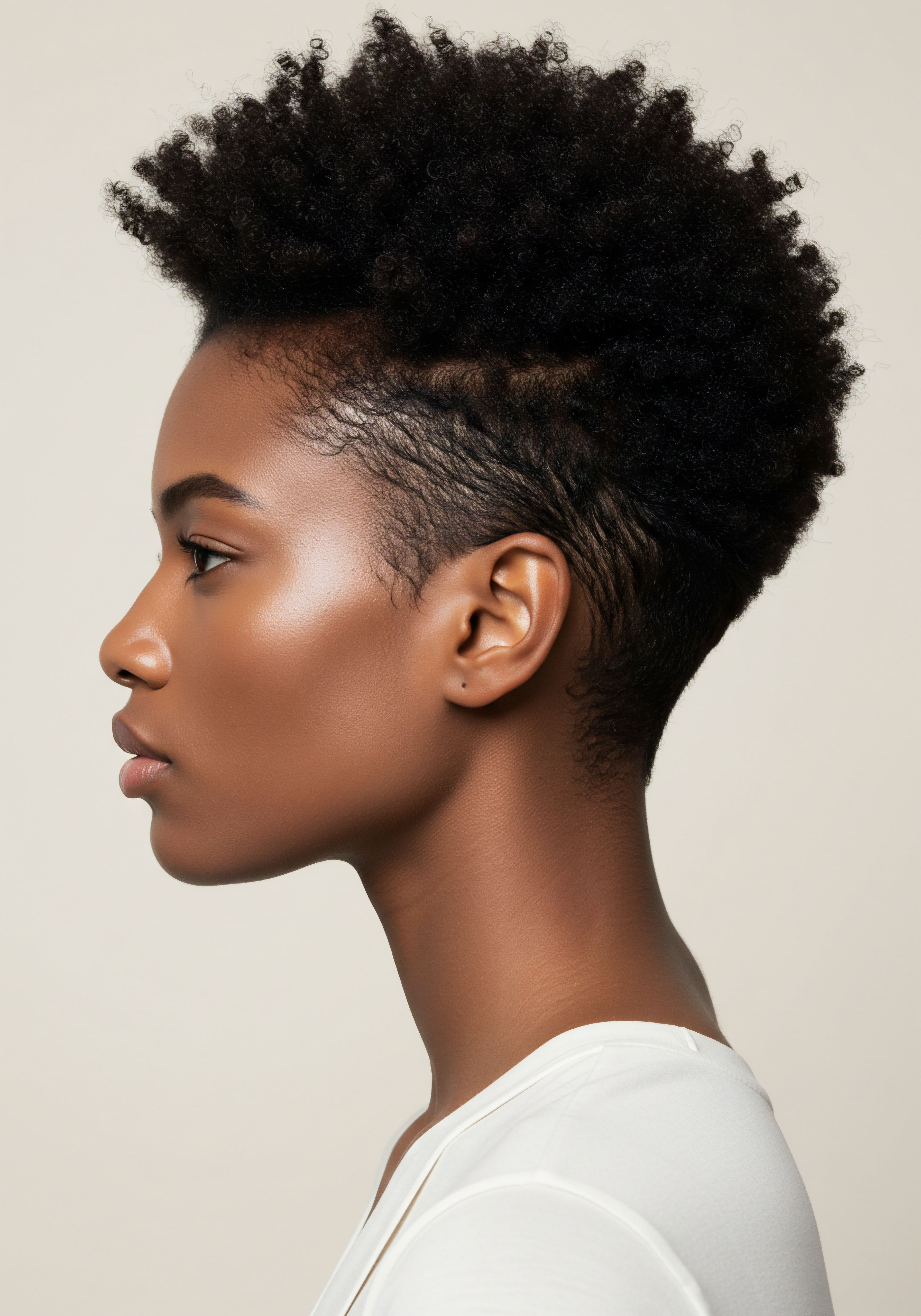
Fundamentals
Within the intricate network of our physical being, where every whisper of internal activity shapes our outward expression, rests a small, butterfly-shaped organ ❉ the thyroid gland. This remarkable endocrine gland, nestled gently at the base of the neck, serves as a quiet maestro, orchestrating a grand symphony of biological processes. Its primary contribution to this bodily chorus comes in the form of specialized chemical messengers, universally known as thyroid hormones. These compounds hold a profound significance, influencing nearly every cell and system within the human body, from the gentle rhythm of a heartbeat to the vibrant health of our hair.
For those of us tending to the unique crown of textured hair, understanding these internal conductors gains an even deeper resonance. The health of our curls, coils, and waves, often viewed through the lens of external care, is profoundly connected to the unseen metabolic dance these hormones direct. Their definition extends beyond mere biochemical composition; it speaks to their pervasive influence on growth, vitality, and the very fabric of our being.

The Gland’s Gentle Hum
The thyroid gland, a delicate structure, produces and releases two principal hormones ❉ Thyroxine (T4) and Triiodothyronine (T3). These iodine-containing molecules are not merely substances; they are vital signals, constantly circulating through our bloodstream, delivering precise instructions to cells throughout the body. The gland’s activity, a testament to nature’s precise design, is carefully regulated by a sophisticated feedback loop involving the hypothalamus and the pituitary gland, ensuring that levels remain within a harmonious range. This meticulous balance is paramount for the continuous operation of our metabolic engines, guiding the pace at which our bodies transform nourishment into energy.
Thyroid hormones, primarily T3 and T4, act as crucial metabolic conductors, influencing nearly every cell in the body.

The Core Messengers ❉ T3 and T4
Thyroxine, or T4, is the more abundant hormone secreted by the thyroid, acting largely as a precursor. Its biological potency becomes fully realized when it undergoes a subtle conversion in peripheral tissues, transforming into T3. T3, the active form, then binds to receptors within cells, initiating a cascade of events that govern cellular metabolism.
This dual-hormone system ensures a steady supply of metabolic regulation, with T4 providing a long-lasting reservoir and T3 delivering immediate, impactful directives. Their combined action affects the body’s basal metabolic rate, protein synthesis, and even the sensitivity of cells to other important biological communicators.
The presence of adequate iodine, a trace mineral, is an absolute requirement for the proper creation of both T3 and T4. Without sufficient dietary iodine, the thyroid gland struggles to produce these essential messengers, potentially leading to an enlarged gland, a condition often recognized as a goiter. This highlights a fundamental connection between our nutritional intake and the subtle, yet powerful, operations within our endocrine system.

First Whispers to Hair
Even at this foundational level, the connection between thyroid hormones and the vitality of our hair begins to reveal itself. These hormones are integral to the very genesis and sustainment of hair follicles, those tiny pockets beneath the skin from which each strand emerges. They participate in stimulating cell multiplication and the production of keratin, the fundamental protein comprising hair. A well-regulated thyroid system thus provides the consistent, gentle nudge that encourages healthy hair growth and maintains its natural resilience.
Consider the myriad ways our hair expresses itself ❉ its texture, its luster, its very capacity for growth. These qualities, often attributed solely to external care routines, are deeply rooted in the body’s internal environment. The thyroid hormones contribute to this internal equilibrium, influencing the hair’s overall quality and its potential for thriving. Their influence extends to regulating the hair’s life cycle, a delicate dance of growth, transition, and rest.

Intermediate
Moving beyond the foundational understanding, the intermediate meaning of thyroid hormones for textured hair care reveals a more nuanced picture of their operational scope. Here, we delve into the intricate feedback loops that govern their release and explore how disruptions within this system can manifest in the tangible reality of our hair. This deeper exploration illuminates the practical applications of this knowledge, informing daily and weekly hair care rituals for curls, coils, and waves.

The Body’s Delicate Balance
The regulation of thyroid hormones is a remarkable example of the body’s self-governing intelligence, a system known as the Hypothalamic-Pituitary-Thyroid (HPT) Axis. This sophisticated communication pathway ensures that the body receives precisely the right amount of T3 and T4 at any given moment. It commences in the hypothalamus, a region of the brain that releases thyrotropin-releasing hormone (TRH). TRH then signals the pituitary gland, positioned at the brain’s base, to secrete thyroid-stimulating hormone (TSH).
TSH, in turn, acts directly upon the thyroid gland, prompting it to produce and release T3 and T4. This chain of command, a constant dialogue, ensures metabolic harmony.
When this delicate balance is disrupted, either by an overproduction (hyperthyroidism) or an underproduction (hypothyroidism) of these vital messengers, the repercussions ripple throughout the body. The symptoms can be varied and often subtle, affecting everything from energy levels and body temperature to mood and, notably, the health of our hair. Recognizing these subtle shifts is a testament to an attuned awareness of one’s own body and its unique needs.

Hair’s Rhythmic Dance and Hormonal Cues
Hair growth follows a predictable, cyclical pattern, a biological rhythm divided into three primary phases ❉
- Anagen Phase ❉ This is the active growth period, spanning several years. During this time, hair follicles are highly active, producing long, strong strands. Thyroid hormones play a stimulating role here, encouraging cell multiplication and keratin production.
- Catagen Phase ❉ A brief transitional period, lasting a few weeks, where hair growth ceases and the follicle begins to shrink. Thyroid hormones assist in regulating the duration of this phase.
- Telogen Phase ❉ The resting phase, typically lasting a few months, after which the hair naturally sheds to make way for new growth.
Each hair follicle operates independently, ensuring that we do not experience mass shedding all at once. This continuous, asynchronous cycle is maintained by a complex interplay of factors, with thyroid hormones serving as essential cues for the healthy progression of each stage.

When the Rhythm Falters ❉ Hair’s Distress Signals
An imbalance in thyroid hormones can significantly disrupt this rhythmic dance, leading to visible changes in hair quality and density.
With Hypothyroidism, where there is an insufficient supply of thyroid hormones, the body’s metabolic processes slow down. This deceleration affects hair follicles, leading to a diminished capacity for sustained growth. Hair may become noticeably dry, brittle, and prone to breakage.
A common manifestation is diffuse thinning, where hair loss occurs progressively across the entire scalp, rather than in distinct patches. This condition, sometimes described as telogen effluvium, signifies that a greater number of hairs than usual have prematurely entered the resting and shedding phases.
Conversely, Hyperthyroidism, characterized by an excessive production of thyroid hormones, can also lead to hair thinning. While the underlying mechanism differs, the outcome for hair can be similar ❉ a disruption in the hair cycle that results in strands appearing finer and less dense. In both scenarios, the hair’s very structure can be compromised, losing its natural luster and resilience. The hair may feel coarse, lose its elasticity, and struggle to retain moisture, a particular concern for textured hair types already prone to dryness.
Imbalances in thyroid hormones can disrupt the hair’s natural growth cycle, leading to dryness, brittleness, and diffuse thinning.

Nurturing Textured Hair Amidst Hormonal Shifts
For those with textured hair, the impact of thyroid imbalances can be especially pronounced. The inherent structure of curls, coils, and waves, with their unique cuticle patterns and propensity for dryness, means that any additional stress from hormonal fluctuations can quickly lead to noticeable fragility.
Consider how a gentle touch becomes even more vital when hair feels compromised. Routines that prioritize hydration and minimize mechanical stress gain heightened significance. This might involve ❉
- Deep Conditioning ❉ Regular, rich conditioning treatments can help to compensate for the dryness that often accompanies thyroid dysfunction, helping strands retain their suppleness.
- Protective Styling ❉ Styles that reduce tension on the scalp and minimize manipulation can prevent further breakage, offering a sanctuary for vulnerable hair.
- Gentle Detangling ❉ Employing wide-tooth combs or fingers with ample slip from conditioners can help navigate tangles without undue stress on weakened hair fibers.
Understanding the internal dialogue of your body, particularly the signals from your thyroid, allows for a more informed and compassionate approach to hair care. It is a reminder that external beauty often reflects internal harmony.

Advanced
The sophisticated explication of thyroid hormones transcends their basic definition, positioning them as cellular architects and epigenetic modulators, especially when viewed through the unique lens of textured hair science and heritage. This advanced understanding necessitates a deeper exploration of their profound significance, drawing upon contemporary research and scholarly perspectives to delineate their full implications. We examine not merely what these hormones are, but the intricate mechanisms by which they shape cellular destiny and influence the very expression of our hair, considering the interplay of biological, historical, psychological, and social factors.

Beyond the Surface ❉ Cellular Orchestration
At an advanced level, thyroid hormones (THs) – primarily T3 and T4 – are understood as ubiquitous transcriptional regulators, exerting their profound influence by binding to specific nuclear receptors (TRs) located within the cells of virtually every tissue. These receptors, once bound by THs, directly influence gene expression, effectively dictating the production of proteins and enzymes essential for metabolic processes, cellular proliferation, and differentiation. This intricate control extends to the most fundamental aspects of cellular life, from energy expenditure within mitochondria to the synthesis of structural proteins. The subtle variations in TR isoform expression across different tissues allow for a highly specific and targeted response to circulating TH levels, ensuring that each cell type, including those within the hair follicle, receives tailored instructions.
This precise molecular dialogue underlies their role in hair follicle homeostasis. THs are not simply general growth promoters; they are critical orchestrators of the hair follicle stem cell niche, influencing the activation and differentiation of these quiescent cells that drive hair cycling. Their presence is required for the proper mobilization of these stem cells from their dormant state, initiating the anagen (growth) phase.
Without optimal TH signaling, the hair follicle’s regenerative capacity is compromised, leading to premature cessation of growth and eventual shedding. This is a testament to the hormonal system’s granular control over our visible characteristics.

The Hair Follicle’s Inner World ❉ A Hormonal Symphony
The hair follicle, a dynamic mini-organ, exists within a complex hormonal milieu, where thyroid hormones interact with a symphony of other endocrine messengers. The dialogue between THs and other hormones, such as androgens, estrogens, and even cortisol, profoundly shapes hair characteristics. For instance, THs are known to increase the proliferation of hair matrix keratinocytes and down-regulate apoptosis, while also influencing melanogenesis, the process that gives hair its color. This interplay is not unidirectional; the metabolic state regulated by THs can, in turn, influence the local conversion and receptor sensitivity of other hormones within the follicular environment.
The expression of deiodinase enzymes within hair follicles, particularly deiodinase 2 (D2), underscores the localized activation of T4 to its more potent form, T3, right where it is needed most. This localized conversion suggests a sophisticated self-regulation within the hair follicle, allowing it to fine-tune its response to systemic thyroid levels. Disruptions in this local conversion can have consequences for hair health, even when systemic TH levels appear within a broad “normal” range. This provides a compelling argument for a more granular assessment of hair-specific hormonal dynamics.

A Nuanced View ❉ Thyroid Health and Textured Hair Realities
When considering the intersection of thyroid hormones and textured hair, a compelling and often underexplored dimension emerges. While some studies indicate a lower prevalence of thyroid disease among African American populations compared to Caucasian groups, hair loss remains a deeply felt concern for nearly half of Black women. This apparent paradox invites a more nuanced examination, revealing how unique hair morphology and cultural practices can amplify the impact of even subtle hormonal shifts.
African hair, with its distinct elliptical cross-section, tighter curl patterns, and fewer elastic fibers, possesses inherent structural characteristics that contribute to its unique beauty and, at times, its vulnerability. It often exhibits decreased tensile strength and lower moisture content compared to other hair types, making it more susceptible to breakage. In this context, even a mild or subclinical thyroid imbalance, which might cause only subtle changes in other hair types, can have a disproportionately significant effect on textured hair. The metabolic slowdown associated with hypothyroidism, for example, can exacerbate the hair’s natural dryness and brittleness, leading to more pronounced diffuse thinning or increased fragility.
Despite a potentially lower prevalence of thyroid disease in African Americans, hair loss remains a significant concern for many Black women, where even subtle thyroid imbalances can amplify hair fragility due to unique hair morphology and styling practices.
A specific illustration of this intersection lies in Trichorrhexis Nodosa (TN), a common hair shaft disorder characterized by weak points along the hair fiber, causing easy breakage. While TN can be acquired through mechanical trauma from styling, it is also linked to underlying conditions like hypothyroidism. Notably, the acquired proximal type of TN is more frequently observed in individuals with African or African-American hair types, often associated with chemical treatments and heat styling practices used to achieve straightened looks.
This confluence of genetic predisposition, styling practices, and underlying hormonal influence creates a unique vulnerability. The presence of hypothyroidism, even subclinical, can render the hair more fragile, making it less resilient to the very styling methods that have been culturally prevalent.
This perspective calls for a culturally attuned approach to hair wellness, recognizing that external hair care practices are inextricably linked to internal physiological states. For a Black woman experiencing hair loss, a comprehensive assessment should extend beyond typical dermatological considerations to include thyroid function, even if the general population statistics might suggest a lower likelihood of overt thyroid disease. The unique response of textured hair to hormonal shifts demands this specialized consideration.

Navigating the Landscape ❉ Implications for Wellness
The advanced understanding of thyroid hormones’ impact on textured hair extends into practical implications for personalized wellness strategies. It suggests that addressing hair concerns in Black and mixed-race individuals requires a holistic perspective that integrates medical insight with cultural sensitivity.
This entails ❉
- Comprehensive Screening ❉ Advocating for routine thyroid function tests as part of general health check-ups, especially for individuals with textured hair experiencing unexplained hair changes, irrespective of broad ethnic prevalence statistics.
- Personalized Care Plans ❉ Developing hair care regimens that acknowledge the inherent structural differences of textured hair and mitigate the impact of hormonal imbalances. This might involve reducing reliance on high-tension styles or excessive heat, and prioritizing deep hydration and protein balance.
- Culturally Competent Dialogue ❉ Fostering open conversations between healthcare providers and individuals about hair health, acknowledging the cultural significance of hair within Black communities and the historical context of styling practices. This helps to bridge the gap between medical diagnosis and lived experience.
The goal is to empower individuals to make informed choices that honor both their physiological needs and their cultural heritage, creating a path to hair wellness that is both scientifically sound and deeply respectful.

The Unseen Impact ❉ Long-Term Hair Health Trajectories
Unaddressed thyroid imbalances can have profound, long-term consequences for hair health, extending beyond mere cosmetic changes. Chronic hormonal disruption can lead to persistent hair fragility, reduced growth potential, and a diminished ability for the hair follicle to recover its full vigor, even after treatment begins. This prolonged state of metabolic disharmony can alter the hair’s structural integrity over time, making it chronically prone to breakage and difficult to retain length.
From a long-term perspective, consistently managing thyroid health becomes a strategic investment in the longevity and vibrancy of textured hair. This is not a quick fix but a sustained commitment to internal balance. Early detection and consistent management of thyroid conditions, through appropriate medical intervention and lifestyle adjustments, can significantly alter the trajectory of hair health, preserving its density, strength, and natural beauty. It is about understanding that the visible hair on our heads is a living testament to the unseen biological processes within, and that true hair wellness springs from this deep, integrated comprehension.

Reflection
Our exploration of thyroid hormones reveals a profound truth ❉ the beauty and vitality of our textured hair are inextricably linked to the delicate, powerful workings within our bodies. It is a gentle reminder that true care extends beyond the products we apply, reaching into the very core of our physiological harmony. Each curl, every coil, every wave tells a story not only of heritage and personal expression but also of the unseen biological currents that shape its journey.
Understanding the subtle influence of thyroid hormones, particularly their unique interplay with textured hair, empowers us with knowledge that is both scientific and deeply personal. It encourages a compassionate attentiveness to our bodies, fostering a sense of gentle stewardship over our well-being. This awareness invites us to listen to our hair’s whispers, recognizing them as signals from within, guiding us toward a more integrated and holistic path to radiant health. May this knowledge serve as a grounding presence, illuminating the path to a flourishing crown, one strand at a time.

References
- Duntas, L. H. & Yen, P. M. (2018). Thyroid hormone and hair growth. British Journal of Dermatology, 179(3), 575-576.
- Safer, J. D. Crawford, T. M. Fraser, L. M. & Naftolin, F. (2001). Thyroid hormone induces hair growth. The Journal of Investigative Dermatology, 117(5), 1319-1322.
- Paus, R. & Cotsarelis, G. (2008). The biology of hair follicles. In L. A. Goldsmith, S. I. Katz, B. A. Gilchrest, A. S. Paller, D. J. Leffell, & W. D. Wolff (Eds.), Fitzpatrick’s Dermatology in General Medicine (7th ed. pp. 953-972). McGraw-Hill Medical.
- Gathers, R. C. & Lim, H. W. (2009). Central centrifugal cicatricial alopecia ❉ past, present, and future. Journal of the American Academy of Dermatology, 60(4), 660-668.
- Aguh, C. (2020). Hair Loss in Black Women ❉ A Concise Guide to Diagnosis and Treatment. Springer.
- Slominski, A. Wortsman, J. & Paus, R. (2020). Skin as an endocrine organ. In S. Melmed, K. S. Polonsky, P. R. Larsen, & H. M. Kronenberg (Eds.), Williams Textbook of Endocrinology (14th ed. pp. 1657-1678). Elsevier.
- Contreras-Jurado, C. Lorz, C. Garcia-Serrano, L. Ramirez, A. & Aranda, A. (2014). Thyroid hormone signaling controls hair follicle stem cell function. Stem Cells, 32(3), 751-762.
- Papadopoulou, O. et al. (2023). Impact of Thyroid Dysfunction on Hair Disorders. Journal of Clinical Medicine, 12(16), 5263.
- Brent, G. A. (2012). Clinical practice. Graves’ disease. The New England Journal of Medicine, 366(16), 1519-1527.
- Werner, S. C. & Ingbar, S. H. (Eds.). (2005). The Thyroid ❉ A Fundamental and Clinical Text (9th ed.). Lippincott Williams & Wilkins.